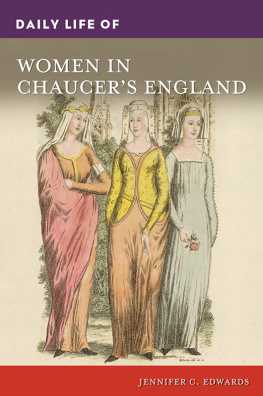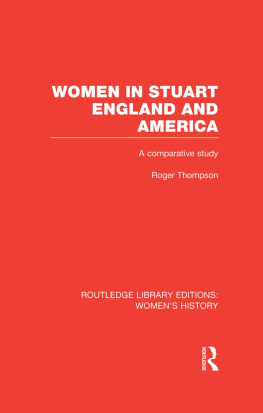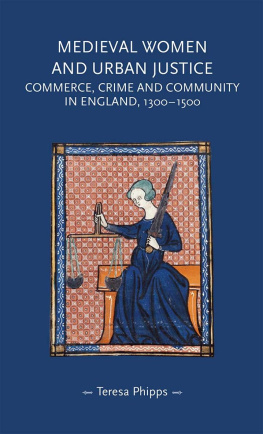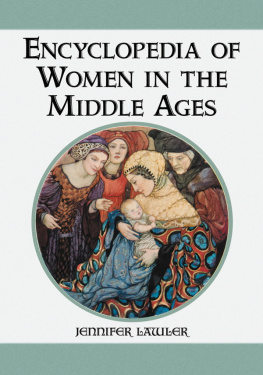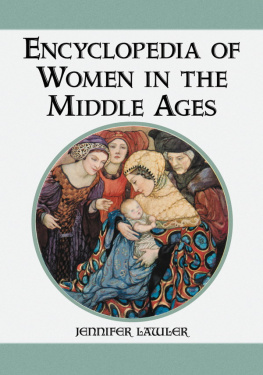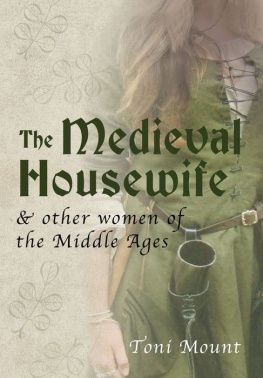About the Author
Jennifer C. Edwards is professor and chair of history at Manhattan College in Riverdale, New York, where she teaches medieval and ancient history. She is the author of Superior Women: Medieval Female Authority in Poitiers Abbey of Sainte-Croix (2019). She earned her PhD and MA from the University of Illinois at Urbana-Champaign and BA from the University of Massachusetts at Amherst. She is an associate editor for the Medieval Feminist Forum and serves on the Advisory Board of the Society for Medieval Feminist Scholarship. She is working currently on a book project, Holy Healing: Saints and Leprosy in the Middle Ages, examining the treatment of leprosy in the medieval cult of the saints.
Most women in medieval England married and started a new household with their husbands. Marriage was a strategy for medieval families to secure alliances, ensure smooth transitions to heirs for family property, and promote social stability. Families used marriage to bring in new property, wealth, and connections; artisans married for a partner with complementary duties to support the shop; peasants married for help running the agricultural household. Yet medieval women and men also expected to find affection and love in their marriages, and love matches certainly took place. Even elites who arranged marriages for their children expected the matches to be harmonious and to become affectionate. Not all marriages could achieve these goals, however; while dissolving a marriage was difficult and challenged by the church, it was possible in some cases.
Paul had advised Christians to marry if they could not remain celibate in his first letter to the Corinthians. Paul wished that all of you were as I am but recognized that since sexual immorality is occurring, each man should have sexual relations with his own wife, and each woman with her own husband (1 Corinthians 7:29). Paul advised the Corinthians that to have sex within marriage was not a sin; even if it was better to remain a virgin and unmarried like Paul, he recognized this was not possible for all Christians. Chaucers Wife of Bath expressed familiarity with this idea in a long passage of her prologue, using a metaphor of fine and lesser quality bread to describe the difference between the celibate and married life. She declared herself comfortable being made of the lesser, coarser bread if it meant she could enjoy sex both for procreation and recreation.
By the time of Chaucer, marriage was governed by canon law in medieval England. Marriage was not permitted within four degrees of consanguinity or blood relationshipso those who shared great-great-grandparents were too closely related to marry. In previous centuries the limit had been for seven degrees of consanguinity, but that restriction proved to be too challenging to enforce, and the 1215 Fourth Lateran Council changed the limitation to four degrees. There were also restrictions based on affinity, prohibiting marriage to ones former sister-in-law, ones own childs godparents, and the relative of a previous sexual partner. Any of these too-close relationshipsfor consanguinity, godparents, or other affinitycould be solved by a special dispensation from the church, but for most people, these were unenforceable restrictions that were largely ignored unless another reason to dissolve the marriage arose, as most famously for Henry VIII in the sixteenth century or Eleanor of Aquitaine and her first husband, Louis VII, in the twelfth. Canon law governed marriage, and documents from the church courts do contain numerous cases attempting to dissolve marriages or resolve issues related to consanguinity and affinity.
After the twelfth century, the Christian church considered marriage to be one of the seven sacraments. This set up a conflict in how the church and some members of the laity understood marriage. On the one hand, parents expected to arrange marriages for their children, which ensured a stable society with legitimate heirs to inherit property. On the other hand, the church stressed the consent of marital partners alone, without reference to the permission of the parents, a model that threatened patriarchal control of children and family. Tension between these models led to court cases disputing the validity of marriages where consent had been given in private, unwillingly, or not at all, with fathers occasionally accusing a new son-in-law of raptusa legal term used to describe abduction, seduction, elopement, and rapein seducing or abducting his daughter. Canon law governed marriage, marital relations, and possible marital dissolutions. Adultery was prohibited for both partners.
Peasants who lived on manors were not required to receive the lords consent to marry after 1234, but elites still interfered in marriages, with particular interest in keeping peasants on the manor and not marrying someone from far away. Marriages on the estate would ensure a lasting workforce, and it was more common for families who knew each other well to encourage marriage within subsequent generations. The strong intervention of lords and families perhaps encouraged couples to cohabitate instead, or to engage in trothplight, exchanging vows before witnesses but without the church. Couples in such informal unions opened themselves up to charges of fornication, which typically fell on the woman.
In the thirteenth century, an English synod created a mechanism to force marriage on repeat fornicatorsonce warned, having sex again would formalize the marriage. For example, in July 1363 William Trumpour and Joan de Gyldesum were charged with fornication and swore that if they were to have sex again they would have to marry (Goldberg 1995, 117). This case demonstrates the churchs interest in curtailing fornication and in pressing recidivist fornicators into marriage where their sexual activity would no longer be a problem. It also displays the sort of miscommunications between men and women around sex and marriage: Joan believed William had already promised marriage, while William denied any betrothal, not willing to take on a wife, even for a woman he bedded. The message was clear, however, that future sexual activity between them would come with a wedding, and with a court record documenting Williams word, he could not in the future pretend Joan misunderstood him. It is also of note that the confession reduced the penalty, but Joan still suffered three whippings. It was possible to avoid this penalty altogether by marrying before the court date, as in 1399 John Esyngwald and Elizabeth Snawe did when they were caught fornicating. John took an oath on the Bible that he would marry Elizabeth when unmentioned obstacles to their wedding were removed and gave a deadline of the feast of St. Mark the Evangelist for the celebration.
In late medieval England, marriage was legal at puberty, twelve for girls and fourteen for boys, but betrothal could be as early as age seven. Mary Percy was married to John de Southeray in 1377 when she was only eight or nine, probably because Alice Perrers, Johns mother and Marys guardian, wanted to make the marriage official because wardship was at risk. Alison, Chaucers Wife of Bath, notes that she was married at age twelve. A betrothal could include future consent, but both parties had to grant consent again at a legal age for the marriage. Marriage for the lower-status groups was later, late teens or early twenties, particularly for those groups that moved to the cities for work that typically delayed marriage.
Present-tense consent, or future-tense consent followed by consummation, was sufficient to make a marriage legal in the eyes of the church court. The large amount of matrimonial litigation demonstrates that marriage was more complicated than simple consent suggests, however, as various parties challenged the legality of the union, or one part of the couple remembered events differently. Witnesses testified to demonstrate that both parties were of age, were free to consent, did consent, or that the marriage was consummated, and their testimony shows how little privacy there was in the Middle Ages for even the most intimate of moments. A York woman named Maud Katersouth testified in 1355 on behalf of Maud de Bradelay, who claimed to be the wife of John de Walkyngton after he offered future-tense consent and they consummated the marriage. Maud Katersouth explained that John called for Maud de Bradelay from his bed, but she declined. She claimed that he then called out, [Y]ou are mine and I am yours.... I refuse to seek permission from you to do my will with you, and that Maud had demanded a formal proposal, which he gave, and Maud responded, [N]ow you can do your will with me (Goldberg 2013, 37).

